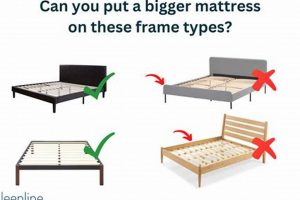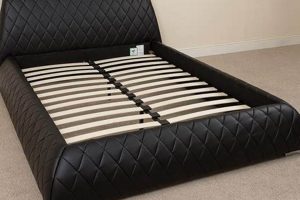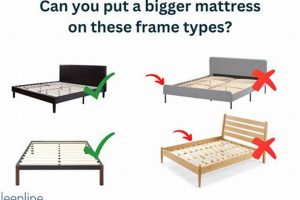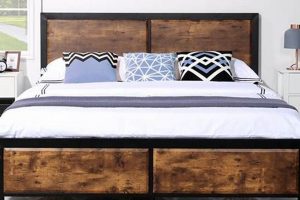The selection of appropriate sleep surfaces for motorized, articulating bed bases is a critical consideration for optimizing comfort and functionality. These specialized beds require mattresses engineered to withstand frequent bending and conforming without compromising structural integrity or support. A primary function of these mattresses is to allow the bed to adjust into various positions, such as elevated head and foot sections, to cater to individual preferences or medical needs.
Utilizing a compatible sleeping surface with these bed frames can significantly enhance sleep quality and provide pressure relief. Historically, innerspring mattresses were not suited for these applications due to their rigid coil systems. Modern foam, latex, and hybrid constructions have revolutionized the suitability of mattresses for these bases, offering enhanced flexibility and durability. The utilization of these mattresses is beneficial for individuals with mobility limitations, back pain, or those seeking enhanced comfort and positioning options.
The subsequent sections will delve into the key features to consider when selecting a suitable sleeping surface, exploring the various material options, construction techniques, and relevant specifications, ensuring informed purchasing decisions for optimal adjustable bed performance. These include flexibility, durability, and suitability for various sleep preferences.
Essential Considerations
Selecting the correct sleeping surface for use with an adjustable bed base necessitates careful evaluation. The following recommendations provide guidance in making an informed decision.
Tip 1: Prioritize Flexibility: The mattress must possess adequate flexibility to conform to the various angles and positions of the adjustable base without damage. Models constructed with all-foam or latex are often superior choices due to their inherent pliability.
Tip 2: Evaluate Thickness and Weight: Excessive mattress thickness can reduce the range of motion of the adjustable base. Heavier mattresses may also strain the motor. Consider the weight capacity of the bed frame and select a mattress accordingly.
Tip 3: Assess Material Durability: The constant flexing of the mattress requires robust construction. Reinforce edges and high-density core materials contribute to longevity and prevent premature sagging.
Tip 4: Consider Motion Isolation: If sharing the bed, evaluate the mattress’s ability to isolate motion. All-foam and certain hybrid models excel in minimizing the transfer of movement, preventing disruptions during sleep.
Tip 5: Verify Warranty Compatibility: Confirm that the mattress warranty remains valid when used with an adjustable bed base. Some manufacturers stipulate usage requirements that must be adhered to.
Tip 6: Evaluate Sleeping Position Compatibility: Different sleeping positions require varying levels of support. Side sleepers benefit from softer surfaces that contour to the body, while back and stomach sleepers may prefer firmer options. Sample different firmness levels to determine the most suitable choice.
Tip 7: Consider Trial Periods: Where possible, take advantage of in-home trial periods. This allows adequate time to determine whether the sleeping surface adequately meets your requirements for comfort and support with the adjustable base.
Adhering to these guidelines will improve the compatibility and performance of the selected sleeping surface, resulting in enhanced comfort and optimal operation.
The subsequent sections will address specific material options in greater detail.
1. Flexibility
Flexibility is a paramount attribute in determining the suitability of a mattress for use with an adjustable bed frame. The direct correlation between mattress flexibility and the functionality of an adjustable base is undeniable. An inflexible mattress impedes the articulation capabilities of the base, preventing it from achieving the desired positions and negating the intended benefits of adjustability. The mattress needs to bend seamlessly with the frame.
In contrast, a flexible mattress readily conforms to the contours of the adjustable bed, allowing for unrestricted movement and optimal positioning. This ensures the user can fully utilize the bed’s features, such as raising the head or foot for reading, watching television, or alleviating specific medical conditions. For example, an all-foam or latex mattress exhibits a high degree of flexibility, accommodating complex bed configurations without compromising support or comfort. This translates to a more ergonomic and comfortable sleep experience, addressing the specific needs of the user.
The long-term durability of both the mattress and the adjustable base is also linked to the mattress’s flexibility. An inflexible mattress subjected to the bending forces of the adjustable frame may experience premature wear and tear, leading to reduced lifespan and potential damage to the base’s motor. Selecting a mattress with inherent flexibility mitigates this risk, ensuring the longevity of both components and providing a superior return on investment. A lack of consideration for this important attribute can result in a costly and ultimately unsatisfactory experience.
2. Thickness
Mattress thickness is a critical parameter when selecting a compatible sleep surface for an adjustable bed frame. The dimensional characteristic influences several functional aspects, impacting both the operational efficiency of the frame and the comfort experienced by the user. Excessive thickness can restrict the range of motion achievable by the adjustable base, effectively limiting its intended versatility. For example, a particularly thick mattress may impede the base’s ability to fully articulate into a seated position or achieve optimal elevation for therapeutic purposes, such as alleviating acid reflux or promoting circulation.
Conversely, insufficient thickness might compromise the support and pressure relief provided by the mattress. While a thinner mattress may conform more readily to the adjustable frame’s contours, it could lack adequate cushioning for the spine and joints. Individuals may experience discomfort or exacerbate existing musculoskeletal issues. This underscores the importance of striking a balance, considering the user’s individual needs and preferences alongside the technical specifications of the adjustable base. The ideal thickness range varies depending on mattress construction and the intended purpose, but generally falls between 10 and 14 inches to ensure both articulation capability and sufficient support.
Ultimately, understanding the implications of mattress thickness is essential for optimizing the functionality of an adjustable bed frame. Careful consideration of this parameter, in conjunction with other factors like mattress material and density, leads to a more comfortable and supportive sleep experience. It ensures that the user fully benefits from the adjustable bed’s features, achieving personalized comfort and addressing specific health or lifestyle needs without compromising the longevity or performance of either the mattress or the adjustable base itself.
3. Durability
The durability of a mattress assumes critical importance when it is paired with an adjustable bed frame. The frequent articulation and repositioning characteristic of adjustable beds place increased stress on the mattress structure, demanding a high degree of resilience to prevent premature degradation and ensure long-term performance.
- Core Material Integrity
The core material of the mattress, be it foam, latex, or innerspring, must possess inherent durability to withstand repeated bending and compression. Low-density foam cores, for example, are prone to sagging and deformation under the stress of an adjustable base, leading to reduced support and comfort over time. High-density foam or latex cores offer greater resistance to these forces, maintaining their structural integrity and providing consistent support for an extended period.
- Edge Support Systems
Enhanced edge support systems are particularly crucial in mattresses designed for adjustable beds. The edges of the mattress are subjected to increased stress as the bed is articulated, and inadequate edge support can result in premature sagging and a compromised sleep surface. Reinforced edges, utilizing high-density foam or steel supports, provide the necessary stability to maintain the mattress’s shape and prevent edge collapse, ensuring consistent support across the entire sleeping surface.
- Fabric and Stitching Quality
The quality of the mattress’s fabric and stitching significantly impacts its overall durability. Low-grade fabrics are susceptible to tearing and stretching under the constant movement of an adjustable bed, while poorly executed stitching can unravel, leading to structural weakness. Durable, high-quality fabrics and reinforced stitching enhance the mattress’s resistance to wear and tear, ensuring its longevity and maintaining its aesthetic appeal.
- Resistance to Compression Set
Compression set refers to the permanent deformation of a mattress material after prolonged compression. Mattresses used on adjustable beds are particularly susceptible to compression set due to the sustained pressure exerted by the adjustable frame. Materials with high resistance to compression set, such as high-density latex or memory foam, retain their original shape and support characteristics, ensuring consistent comfort and preventing the development of permanent indentations.
These considerations highlight that durability is not merely a desirable trait, but a necessity for mattresses intended for use with adjustable bed frames. Selecting a mattress constructed with durable core materials, reinforced edges, high-quality fabrics, and compression-resistant materials ensures long-term performance, optimal comfort, and a sustained return on investment.
4. Material Density
Material density, a critical factor in mattress construction, exerts a significant influence on the performance and longevity of mattresses utilized with adjustable bed frames. The density of the core materials, primarily foam and latex, directly correlates with the mattress’s ability to withstand the constant bending and articulation inherent in adjustable bed usage. Lower density materials are demonstrably more susceptible to compression set and structural degradation under the repeated stress of contouring to the adjustable frame’s positions. For instance, a low-density polyurethane foam mattress may exhibit premature sagging and a loss of support in areas that experience frequent bending, such as the head and foot sections of the bed. This can lead to compromised sleep quality and reduced therapeutic benefits of the adjustable frame. High-density materials, conversely, offer superior resistance to these stresses, maintaining their shape and providing consistent support over extended periods.
The practical significance of understanding material density extends to the consumer’s purchasing decision. While higher density materials often command a higher initial price point, the increased durability and extended lifespan can represent a more cost-effective investment in the long term. Furthermore, the selection of an appropriately dense mattress is crucial for maximizing the adjustable bed frame’s functionality. A mattress lacking sufficient density may hinder the frame’s articulation, preventing it from achieving the desired positions or causing uneven distribution of pressure. Consider a scenario where an individual utilizes an adjustable bed to alleviate back pain; a low-density mattress may fail to provide adequate support in the lumbar region as the bed is elevated, negating the intended therapeutic effect. This underscores the necessity of prioritizing material density when choosing a mattress for an adjustable bed frame, ensuring optimal performance and sustained comfort.
In summary, material density is inextricably linked to the suitability and performance of mattresses for adjustable bed frames. Its influence spans from the mattress’s ability to withstand stress and maintain its shape to its capacity to effectively support the user and enhance the therapeutic benefits of the adjustable bed. While other factors, such as mattress construction and materials, play a role, material density remains a key determinant of durability, support, and overall value. Careful consideration of this parameter is essential for ensuring a comfortable, supportive, and long-lasting sleep experience with an adjustable bed frame.
5. Motion Isolation
Motion isolation, the capacity of a mattress to minimize the transfer of movement across its surface, assumes heightened importance when paired with an adjustable bed frame. The functionality of an adjustable bed, designed to alter position and elevation, inherently creates opportunities for motion transfer. This becomes particularly relevant when the bed is shared, where one individual’s adjustments may disrupt the sleep of the other. The absence of effective motion isolation can negate the comfort and restorative benefits sought through the use of an adjustable base. For instance, if one partner elevates the head of the bed for reading while the other attempts to sleep, the resulting movement and shifting weight can transmit through a poorly designed mattress, causing disturbance and hindering sleep onset.
The selection of a mattress with superior motion isolation capabilities is thus essential for optimizing the shared adjustable bed experience. Certain mattress constructions excel in this area. Memory foam mattresses, known for their contouring properties, effectively absorb movement at the point of impact, preventing it from propagating across the surface. Similarly, pocketed coil systems, wherein each spring is individually wrapped, minimize motion transfer by isolating the response to pressure. In contrast, traditional innerspring mattresses, with interconnected coils, tend to transmit movement more readily. The practical implications of this distinction are significant. A couple using an adjustable bed for various purposes such as alleviating snoring, addressing acid reflux, or simply enjoying personalized comfort positions will experience a far more harmonious and undisturbed sleep environment when the mattress effectively isolates motion.
In summary, motion isolation is not merely a desirable feature but a critical performance characteristic for mattresses intended for use with adjustable bed frames. Its presence or absence directly influences the quality of sleep, particularly in shared beds, and determines the degree to which the benefits of adjustability are realized. By understanding the principles of motion isolation and selecting mattresses with proven capabilities in this area, individuals can maximize their investment in an adjustable bed system and achieve a more restful and undisturbed sleep experience. Failure to prioritize motion isolation can compromise the intended advantages of adjustability, leading to disrupted sleep and a diminished return on investment.
6. Warranty Compatibility
Warranty compatibility is a crucial consideration when selecting a mattress for use with an adjustable bed frame. The interplay between the mattress and the adjustable base places specific demands on the mattress’s construction and materials, which may affect the validity of the manufacturer’s warranty. Failure to ensure compatibility can lead to voided warranties and unexpected expenses should the mattress experience premature wear or damage.
- Explicit Usage Stipulations
Many mattress manufacturers include specific clauses in their warranties that address the use of their products with adjustable bed frames. These stipulations may outline the types of adjustable bases deemed acceptable or impose limitations on the degree of articulation permitted. Non-compliance with these explicit usage stipulations can automatically invalidate the warranty, leaving the consumer responsible for repair or replacement costs. For example, a warranty may be voided if the mattress is used on an adjustable base not explicitly approved by the mattress manufacturer.
- Structural Integrity and Support Requirements
Adjustable bed frames subject mattresses to bending and flexing forces that are not typically encountered with traditional flat foundations. As such, mattress warranties often include provisions related to structural integrity and support. If the mattress’s internal components, such as coils or foam layers, fail prematurely due to the stress imposed by the adjustable base, the warranty may be deemed void if the manufacturer determines that the bed frame was a contributing factor. This underscores the importance of selecting a mattress specifically designed to withstand the demands of an adjustable base.
- Weight Restrictions and Distribution
Most mattress warranties include weight restrictions, specifying the maximum weight the mattress can safely support without compromising its structural integrity. Adjustable bed frames can alter the distribution of weight across the mattress surface, potentially exceeding these limits in certain areas. If the mattress exhibits sagging or deformation due to excessive weight or uneven distribution caused by the adjustable base, the warranty may not cover the resulting damage. Therefore, it is essential to consider the weight capacity of both the mattress and the adjustable bed frame and ensure compatibility.
- Damage Assessment and Proof of Compatibility
In the event of a warranty claim, mattress manufacturers often require proof that the mattress was used in accordance with their guidelines, including compatibility with the adjustable bed frame. This may involve providing documentation of the bed frame’s specifications or undergoing an inspection by a qualified technician. If the manufacturer determines that the damage was caused by improper use or an incompatible bed frame, the warranty claim may be denied. Consumers should maintain records of their purchase and usage of both the mattress and the adjustable bed frame to facilitate potential warranty claims.
The relationship between warranty compatibility and selecting a mattress for an adjustable bed frame is inextricably linked. Adherence to warranty guidelines not only safeguards the consumer’s investment but also ensures optimal performance and longevity of the sleep system. Prudent consumers carefully review warranty terms and conditions, seek guidance from knowledgeable retailers, and prioritize mattresses specifically designed for adjustable base compatibility, thereby minimizing the risk of unexpected expenses and maximizing the benefits of their investment.
Frequently Asked Questions
The following questions address common concerns regarding the selection and use of mattresses with adjustable bed frames. This information aims to clarify important considerations for optimal performance and longevity.
Question 1: What mattress types are best suited for adjustable bed frames?
All-foam, latex, and hybrid mattresses with flexible coil systems are generally recommended for adjustable bed frames. These materials conform readily to the bed’s articulation without compromising support.
Question 2: Does mattress thickness affect adjustable bed frame performance?
Yes. Excessive mattress thickness can restrict the range of motion of the adjustable frame. A mattress thickness between 10 and 14 inches is typically optimal.
Question 3: How does mattress durability relate to adjustable bed frame compatibility?
Adjustable beds subject mattresses to repeated bending, necessitating robust construction. Mattresses with reinforced edges and high-density core materials offer improved durability.
Question 4: Is motion isolation important for mattresses on adjustable bed frames?
Motion isolation is particularly important when the bed is shared. Mattresses with effective motion isolation prevent disturbances caused by one partner adjusting the bed.
Question 5: Does using an adjustable bed frame void my mattress warranty?
Potentially. Some mattress warranties have specific stipulations regarding adjustable bed frame compatibility. Verify the warranty terms to ensure compliance and avoid voiding coverage.
Question 6: What role does material density play in mattress suitability for adjustable bed frames?
High-density materials, such as latex or memory foam, offer superior resistance to compression set and deformation, ensuring consistent support over time, which is crucial for adjustable bed frame applications.
These FAQs provide a foundational understanding of key aspects of mattress selection for adjustable bed frames. Consideration of these elements will lead to a more informed purchase decision.
The subsequent section will address strategies for optimizing comfort and support with an adjustable bed frame.
Conclusion
The preceding discussion has explored critical factors in selecting an appropriate sleep surface for motorized, articulating bed bases. Considerations of flexibility, thickness, durability, material density, motion isolation, and warranty compatibility are paramount. A proper mattress selection ensures both user comfort and the sustained operational effectiveness of the adjustable bed frame.
Optimal integration of the mattress and adjustable bed frame hinges on a comprehensive understanding of individual needs and the technical specifications of both components. Future advancements in materials science and ergonomic design will likely yield even more specialized solutions, further enhancing the potential benefits of adjustable bed technology. Vigilant attention to these considerations remains essential for maximizing user satisfaction and achieving long-term value.


![Best Queen Size Bed Frame with Mattress [Deals] Organic & Natural Mattress Buyer’s Guide: Non-Toxic Sleep Solutions Best Queen Size Bed Frame with Mattress [Deals] | Organic & Natural Mattress Buyer’s Guide: Non-Toxic Sleep Solutions](https://mattressworldpa.com/wp-content/uploads/2025/07/th-3082-300x200.jpg)




![Best Queen Futon Mattress & Frame [Deals + Guide] Organic & Natural Mattress Buyer’s Guide: Non-Toxic Sleep Solutions Best Queen Futon Mattress & Frame [Deals + Guide] | Organic & Natural Mattress Buyer’s Guide: Non-Toxic Sleep Solutions](https://mattressworldpa.com/wp-content/uploads/2025/07/th-3077-300x200.jpg)